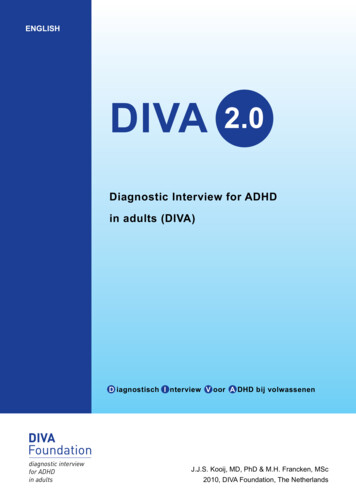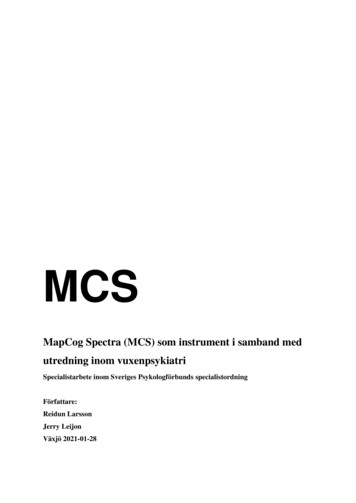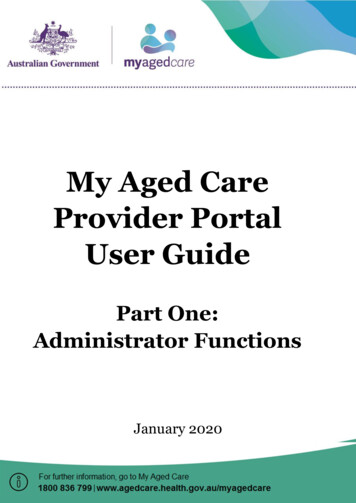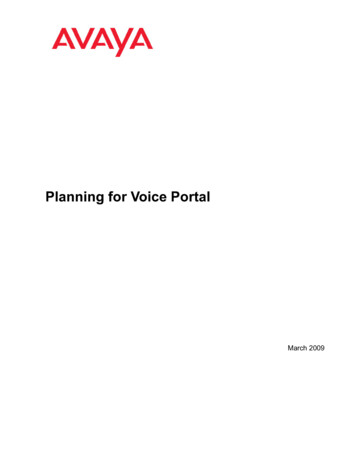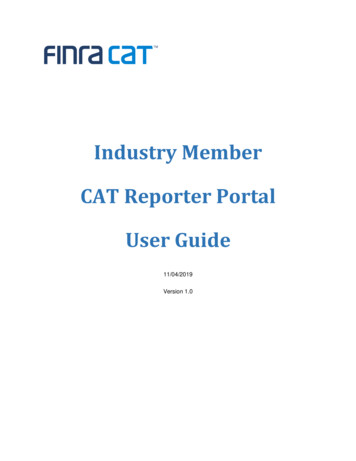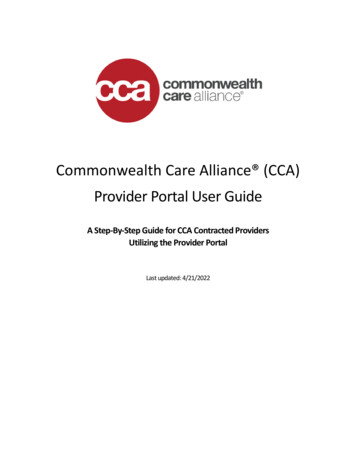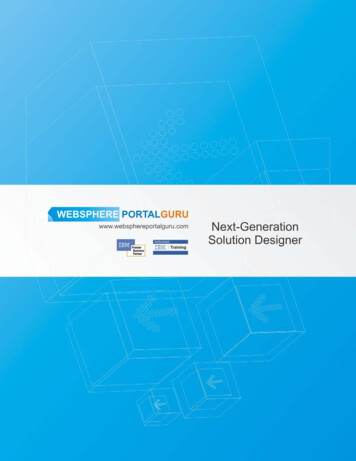
Transcription
ralucaVern aciesLiterand FuturetneserP,tPaslund,atrine EdCnugennA:anne HasuEditorsS&dEdlunLars-Erik
Ann-Catrine Edlund, Lars-Erik Edlund & Susanne Haugen (eds.)Vernacular Literacies– Past, Present and FutureNorthern Studies Monographs 3Vardagligt skriftbruk 3Published by Umeå University andRoyal Skyttean SocietyUmeå 2014
The editorial board of Vardagligt skriftbruk has selected peer reviewers for this content. The authors, the series Northern Studies Monographs and Vardagligt skriftbruk.Department of Language Studies, Umeå University, SE-901 87 Umeå.Design and layoutOrd & Co i Umeå ABFonts: Berling Nova and FuturaPaper: Invercote Creato 260 gr and Artic volume high white 115 grPrinted byTMG TabergsISBN 978-91-88466-86-0ISSN 2000-0405
ContentsIntroduction. . . . . . . . . . . . . . . . . . . . . . . . . . . . . . . . . . . . . . . . . . . . . . . . . . . . . . . . . . . . . . . . . . . . . . . . . . . . . . . . . . . . . . . . . . . . . . . . . . . . . . . . . . . . 5Vernacular Literacies – In the PresentDeborah Brandt. Deep writing. New Directions in Mass Literacy . . . . . . . . . . . . . . . . . . . . . . . . . . . 15Anna-Malin Karlsson. Writing in Your Own Voice? Managing InterpersonalMeanings in Elder Care Literacy Practices. . . . . . . . . . . . . . . . . . . . . . . . . . . . . . . . . . . . . . . . . . . . . . . . . . . . . . . . . . . . 29Zoe Nikolaidou. Dominant Workplace Literacies in Vernacular Disguise.Disputable Discourses on the Production Floor . . . . . . . . . . . . . . . . . . . . . . . . . . . . . . . . . . . . . . . . . . . . . . . . . . . . . 45Theres Bellander. Gammalt möter nytt – En analys av ålderspensionärersdigitala skriftpraktiker . . . . . . . . . . . . . . . . . . . . . . . . . . . . . . . . . . . . . . . . . . . . . . . . . . . . . . . . . . . . . . . . . . . . . . . . . . . . . . . . . . . . . . . . . . . 59Karin Hagren Idevall. ”Ge mig dina källor på det innan jag tror på det, framtill dess kommer jag skratta åt det påståendet”. En språkvetenskaplig studieav relationer i kommentarsfält online. . . . . . . . . . . . . . . . . . . . . . . . . . . . . . . . . . . . . . . . . . . . . . . . . . . . . . . . . . . . . . . . . . . 77Anna Malmbjer. Administrativa skriftpraktiker i undervisningspraktikeneget arbete . . . . . . . . . . . . . . . . . . . . . . . . . . . . . . . . . . . . . . . . . . . . . . . . . . . . . . . . . . . . . . . . . . . . . . . . . . . . . . . . . . . . . . . . . . . . . . . . . . . . . . . . . . . . . 91Vernacular Literacies – In the PastMagnus Källström. Birka, Sigtuna och Medelpad – glimtar från tre vikingatidaskriftmiljöer. . . . . . . . . . . . . . . . . . . . . . . . . . . . . . . . . . . . . . . . . . . . . . . . . . . . . . . . . . . . . . . . . . . . . . . . . . . . . . . . . . . . . . . . . . . . . . . . . . . . . . . . . 107Ivar Berg. Rural Literacy in Sixteenth Century Norway. . . . . . . . . . . . . . . . . . . . . . . . . . . . . . . . . . . . . . . . . 125Rut Boström. ”Då hågen leker på örterna utanföre”. Inslag av vardagsspråki 1700-talets vetenskapliga brevskrivande . . . . . . . . . . . . . . . . . . . . . . . . . . . . . . . . . . . . . . . . . . . . . . . . . . . . . . . . . . . . . 137Jan Ragnar Hagland. Etterreformatoriske runer og kvardagsleg skriftpraksispå 1800-talet. . . . . . . . . . . . . . . . . . . . . . . . . . . . . . . . . . . . . . . . . . . . . . . . . . . . . . . . . . . . . . . . . . . . . . . . . . . . . . . . . . . . . . . . . . . . . . . . . . . . . . . . . . 155Loftur Guttormsson. Fra fraktur til antikva. Vidnesbyrd fra 1800-tallets Island . . . . . . . 165Erla Hulda Halldórsdóttir. “Don’t you forget your always loving sister”.Writing as a Social and Cultural Capital . . . . . . . . . . . . . . . . . . . . . . . . . . . . . . . . . . . . . . . . . . . . . . . . . . . . . . . . . . . . . . . 181Tereza Lansing. Manuscript Culture in Nineteenth Century Northern Iceland.The Case of Þorsteinn Þorsteinsson á Heiði. . . . . . . . . . . . . . . . . . . . . . . . . . . . . . . . . . . . . . . . . . . . . . . . . . . . . . . . . 193Bragi Þorgrímur Ólafsson. Manuscripts and Social Media. The Case ofRagnheiður and Andrés . . . . . . . . . . . . . . . . . . . . . . . . . . . . . . . . . . . . . . . . . . . . . . . . . . . . . . . . . . . . . . . . . . . . . . . . . . . . . . . . . . . . . . . . 213Anna Kuismin. “I can sing Hallellujah!” Hymn as Non-Elite Women’sGenre in Nineteenth-Century Finland. . . . . . . . . . . . . . . . . . . . . . . . . . . . . . . . . . . . . . . . . . . . . . . . . . . . . . . . . . . . . . . . . 223Karin Strand. ”Mitt liv skall jag förtälja för Eder uti sång”. Om förhållandetmellan liv och text i blindvisor: exemplen Karl Joelsson och Viktor Lindrot . . . . . . . . 239Laura Stark. The Rise of Finnish-Language Popular Literacy Viewed throughCorrespondence to Newspapers 1856–70 . . . . . . . . . . . . . . . . . . . . . . . . . . . . . . . . . . . . . . . . . . . . . . . . . . . . . . . . . . . . . . 261Sami Suodenjoki. Whistleblowing from Below. Finnish Rural Inhabitants’ Lettersto the Imperial Power at the Turn of the Twentieth Century. . . . . . . . . . . . . . . . . . . . . . . . . . . . . . . 2793
Linda Huldén. Frågeslistsvar som exempel på vardagligt skriftbruk iSvenskfinland på 1900-talet . . . . . . . . . . . . . . . . . . . . . . . . . . . . . . . . . . . . . . . . . . . . . . . . . . . . . . . . . . . . . . . . . . . . . . . . . . . . . . . . . 295Katre Kikas. Folklore Collecting as Vernacular Literacy. Establishing aSocial Position for Writing in the 1890s Estonia. . . . . . . . . . . . . . . . . . . . . . . . . . . . . . . . . . . . . . . . . . . . . . . . . . . 309Contributors . . . . . . . . . . . . . . . . . . . . . . . . . . . . . . . . . . . . . . . . . . . . . . . . . . . . . . . . . . . . . . . . . . . . . . . . . . . . . . . . . . . . . . . . . . . . . . . . . . . . . . . .3244
IntroductionThis anthology is the outcome of a Nordic literacy-conference held at UmeåUniversity in Sweden, 13–15 June 2012, “Vernacular Literacies—Past, Presentand Future.” The conference was hosted and organised by the Nordic network Vernacular Literacies, in cooperation with the Nordic project Readingand Writing from Below.1Vernacular literacy practices have become increasingly prominent features in everyday life, especially in social media through digital technologies.However, vernacular literacy is not a new phenomenon. The written wordhas been used for everyday purposes throughout history, in other media andusing different technologies. Whether historical or modern, vernacular literacy practices have arisen out of everyday needs and are learned informally,where literacy learning rarely is separated from the practice itself.The conference aimed at bringing together Nordic researchers from different disciplines, who study either contemporary or historical literacy, inthe hope that the different perspectives would enrich each other and new research questions and theoretical approaches could be discussed. The overallaim was reached, since many researchers participated with issues on vernacular literacies from an interdisciplinary angle: didactic, historical, ethnological, linguistic and literary aspects of literacy were regarded. The distributionbetween historical and contemporary studies was also just about even.The conference was honoured to present three internationally wellknown plenary speakers. Professor David Barton, Lancaster University, gaveinsights into contemporary vernacular literacy practices in his lecture “FromLocal Literacies to Digital Literacies. Tracing Changes as Vernacular Practices go Online.” Professor Deborah, Brandt, University of Wisconsin-Madison,reflected on mass literacy during the nineteenth and twentieth centuriesunder the heading “Taking Writing Seriously. New Directions in Mass Literacy.” Professor Wim Vandenbussche, Vrije Universiteit, Brussels, contributeda historical perspective on literacy: “From Letter Drawing to Writing Letters—a Look at Historical Literacy from Below.”A total of 77 participants took part in the conference, where 57 paperswere given. During the three days of conference there were four parallel paper1The Nordic network Vernacular Literacies (‘Vardagligt skriftbruk. Diakrona perspektivpå literacy i Sverige och övriga Norden’) was funded by Stiftelsen Riksbankens Jubileumsfond (‘The Swedish Foundation for Humanities and Social Sciences’), coordinatedfrom Umeå University. The conference completed the activities of the three-year lasting network (2009–2012). The Nordic project Reading and Writing from Below. Toward aNew Social History of Literacy in the Nordic Sphere During the Long Nineteenth Century wasfunded by the Joint Committee for Nordic Research Councils for the Humanities andthe Social Sciences 2011–2014, coordinated from Helsinki University.5
sessions with contributions in English and Scandinavian languages. Researchers were represented from Denmark, Iceland, Norway, Finland and Estonia.Twenty papers from the conference are presented in this multi-lingualvolume. There is an equal distribution between articles in English and in theScandinavian languages, mainly articles in Swedish, one in Danish and onein Norwegian. The articles written in Swedish, Danish or Norwegian are accompanied by abstracts in English. The volume is divided into two sections:Vernacular Literacies in the Present, and Vernacular Literacies in the Past. Someof the articles in the sections touch upon the future of vernacular literacies.Vernacular Literacies in the PresentThe section Vernacular Literacies in the Present includes six articles and startswith the article “Deep Writing. New Directions in Mass Literacy” by the plenary speaker Deborah Brandt. New models of literacy development, basedprimarily on writing, are explored in the article. Previously mass literacy wasalmost exclusively described from the reading perspective, but we are nowentering an era of deep writing due to shifts in the nature of work and theaffordances of digital communication. Writing has become the critical skillof consequence in everyday life in this second stage of mass literacy.Workplace literacies in a Swedish-speaking context are dealt with in twoarticles. Writing practices in elder care are the focus of study in the article byAnna-Malin Karlsson: “Writing in Your own Voice? Managing InterpersonalMeanings in Elder Care Literacy Practices.” The article explores the discursive dilemmas in elder care literacy practices where the personal work-identity of care workers is suppressed in writing since the texts are supposed tobe neutral. The focus is on interpersonal meaning and how personal and subjective stances are taken or avoided in writing and in an oral meeting. Thestudy reveals “how the use of heterogloss, i.e. invoking other voices, makes itpossible to convey relevant information without breaking the institutionalrules of neutral writing.” Practices drawn upon by machine operators in a carfactory in Sweden are presented by Zoe Nikolaidou in “Dominant WorkplaceLiteracies in Vernacular Disguise: Disputable Discourses on the ProductionFloor.” The main aim of the article is to show that the concepts of vernacular and dominant literacy practices are problematic in a workplace setting. Itis argued that a focus should instead be placed on the distinction betweeninstitutional and professional discourse. The car factory in this ethnographicstudy has introduced a total quality system and is highly textualized. Theinstitutional discourse is evident in all documentation practices. By exercising a professional discourse, the workers resist the dominant nature of thesetexts, a resistance that is based upon their professional experience and theireveryday social practices at the workplace.6
Two articles are concerned with digital literacies in a Swedish-speakingcontext. Theres Bellander presents a study of elderly people engaged in vernacular literacy practices using digital tools, such as the computer. Her contribution is entitled “The Old Meets the New—an Analysis of Elderly People’s Digital Literacy Practices.” The purpose is to identify and describe theliteracy practices via participant logs and interviews with the participants.The study shows that digital and non-digital tools are used simultaneously.New practices have emerged due to digitalization, and long-time practiceshave taken new forms. The focus of the next study is the comments sectionson a Swedish newspaper website, Aftonbladet, dealing with digital literacies,by Karin Hagren Idevall, “‘Give me your Sources for that Before I Believe it,Until then, I Will Laugh at that Statement.’ A Linguistic Study of Relationsin Comments Sections Online.” An Actor–Network perspective is appliedin this study of the online interaction. The analysis shows that there are twocompeting aims of the comments section. The regulations of the contentare challenged by comments that advocate freedom of speech and racist discourses are justified through a discourse on objectivity.Literacy practices in the educational domain are in focus in AnnaMalmbjer’s article “Administrative Literacy Practices in the Teaching Practice Own Work.” The study is conducted in a Swedish comprehensive schoolin lower secondary classroom settings, through observations and interviews.Two common literacy practices were examined in the teaching practice independent work (eget arbete)—a common teaching practice where the studentsare expected to assume responsibility for their own learning process. Thepractices were found to be highly complex and thereby some students areexcluded from this learning practice.Vernacular Literacies in the PastThe section Vernacular Literacies in the Past embraces literacy practicesthrough the Viking Age to the beginning of the twentieth century and includes 14 articles in total. Runic literacy in the Viking Age and nineteenthcentury in Norway and Sweden, is studied in two articles by Magnus Källström and Jan Ragnar Hagland respectively. The first contribution, Källström’s “Birka, Sigtuna and Medelpad—Glimpses of Three Writing Environments in the Viking Age,” discusses aspects of vernacular literacy byanalysing the material from different places in Viking Age Sweden. In Birkathe runic inscriptions representing the first two centuries of the Viking Ageshow that different variants of the runic alphabet were used, though the socalled short-twig runes probably dominated. In Sigtuna, where the inscriptions are often connected to specific settings and dated fairly closely, thestudy of the runic material indicates a change in the literary practices with7
more people learning how to write and read runes. In Medelpad the traditional memorial inscriptions in stone may show how runes were used formore practical needs in everyday life.Hagland’s article under the title “Runic Writing in the Post-Reformation Era and Everyday Writing in Nineteenth Century Norway and Sweden,”deals with the use of post-reformatorical runes (‘the youngest runes’) in aSwedish and Norwegian context from the second half of the nineteenth century. The discussion takes its point of departure from traditions of writingin runes in a small Western Norwegian community ca. 1850–1880, a traditionthat could be seen as an expression of ‘literacy from below,’ independent ofthe schooling system. The Swedish runes from the same period are discussed,as well as the American Mid-West use from the 1870s and 1880s. To a largeextent, runic usage of this kind seems to have served the purpose of secretscript, displaying an advanced level of local literacy of ‘the youngest runes.’The contribution presented in the conference volume by Ivar Berg, “Rural Literacy in Sixteenth Century Norway,” discusses how the importanceof literacy in the beginning of the early Modern era affected the commonman in Norway. People were members of communities that relied on written testimonies, they were accustomed to hearing charters read out loud, andthey knew how they were supposed to sound. The charters are evaluated assources of our understanding of the literary or textual culture in this article.Rut Boström’s contribution has the title “‘Då hågen leker på örternautanföre’ [‘When One’s Mind is Full of Pleasant Thoughts of the Herbs Outside’]. Components of Everyday Language in Eighteenth-Century ScientificLetters.” The author discusses the letters to Carolus Linnaeus in the 1770sfrom his disciple Anders Sparrman where Sparrman presents his scientificdiscoveries but also delivers personal reflections. The turn from scientific issues to personal thoughts leads to linguistic and stylistic changes. When, forexample, emotional and sentimental issues are in focus, the vernacular character seems more prominent. The letters by other disciples show the samevariation. The degree of vernacular language also seems to vary dependingon the individual’s relationship to Linneaus. Through such a close reading,the thoughts and feelings in a text could bring forth the image of a personin specific contexts. Some methodological problems with such interpretativestylistics are touched upon.The main part of this section of vernacular literacy practices in the pastconsists of articles concerned with the nineteenth century, with a specific focus on handwritten documents by ordinary people in Finland and Iceland. Three articles deal with literacy practices in a Finnish-speaking context during the nineteenth century. In the article “‘I Can Sing Hallelujah!’Hymn as Non-Elite Women’s Genre in Nineteenth-Century Finland” Anna8
Kuismin focuses on women and hymns in nineteenth-century Finland. Thiscase study takes as its point of departure an interesting notebook written byKaisa Juhantytär (1782–1856). The notebook consists of a preface and elevenhymns. It shows Kaisa Juhantytär’s need for self-assertion and must also beseen in the context of revivalism. However, it is not clear if Kaisa wrote to bepublished, for a more selected audience or for her own pleasure.The path to functional literacy for Finnish-speaking commonersthrough letters to newspapers, is presented by Laura Stark in the article “TheRise of Finnish-Language Popular Literacy Viewed through Correspondenceto Newspapers 1856–1870.” The rise of Finnish-language newspapers in the1860s gave Finnish-speaking commoners a reason to write for the first time.At the time, the press represented the only forum for political debate wherethe commoners could participate. The article presents how and why thenon-elite writers began to write to newspapers and the social tensions thatarose when the rural writers entered the public sphere. The letters to thepress provide important information on the self-educated writers' motives.Letters to the Russian imperial administration from Finnish-speakingrural people are presented as fruitful historical sources in Sami Suodenjoki’sarticle “Whistleblowing from Below: Finnish Rural Inhabitants’ Letters tothe Imperial Power at the Turn of the Twentieth Century.” The letters arehere called “whistleblowing from below” since there are letters of petitions,complaints and denunciations demanding authoritative interventions. Theletters were sent to the Governor-General of Finland in 1898–1905 by unschooled tenants, farmers and agriculture labourers, sometimes with the aidof intermediaries. In the letters the rural senders fashioned their politicalidentity, and they can thus be called performative texts, the author argues.The study shows that the letters, however, rarely changed their senders’ status.Three articles deal with literacy practices in Iceland, exercised in themanuscript culture and in letter writing. The features of a handwritten manuscript owned by an ordinary woman in mid-century Iceland is comparedwith the features of contemporary social media by Bragi Þorgrímur Ólafssonin the article “Manuscripts and Social Media: The Case of Ragnheiður andAndrés.” The author argues that the manuscript was to a certain extent a typeof social media: the content is user-generated, it had a wide reach since it wascirculated from one farm to another and there was an interactive dialogue onthe flyleaf, where the readers stated their opinions of the manuscript.In her article “Manuscript Culture in Nineteenth-Century NorthernIceland. The Case of Þorsteinn Þorsteinsson á Heiði,” Tereza Lansing studies the manuscript network of the unschooled farmer and scribe ÞorsteinnÞorsteinsson (1791–1863) from the farm Heiði in the Skagafjörður region9
in northern Iceland. Through this investigation, some important themescould be illustrated: the interaction between learned and popular cultures,the social stratification of the rural manuscript community, and the function of literacy. Due to the influence of the Hólar bishopric, the literacyand book-culture seem to have developed in Skagafjörður. Folk-genres andlearned genres seem to have crossed traditional social strata, and reading material was exchanged and copied within different social groups. The farmerswho copied books also had other occupations that required writing skills.Þorsteinn Þorsteinsson was obviously part of a rural elite, according to theauthor.“‘Don’t you Forget your Always Loving Sister’. Writing as a Social andCultural Capital” is the title of the contribution presented by Erla HuldaHalldórsdóttir. It has been argued that separation plays a vital role in correspondences in times past, and may even start a correspondence; lettersbecome a substitute for the one not present. So may be the case with theepistolarium of Sigríður Pálsdóttir’s (1809–1871) family. But according to theauthor the correspondence also offers “a venue for self-expression and networking and even of manipulation.” Erla Hulda Halldórsdóttir also arguesfor the importance for women to be able to write for themselves.Loftur Guttormsson’s article “From Gothic to Roman Print Type. Evidence from 19th Century Iceland” throws light on the change from theGothic to the Roman type in the print culture of nineteenth century Iceland compared with the situation in Denmark and Norway. Religious literature proved to be the most resistant to change from Gothic to Roman print.Special attention is given to the role that ABC books played in the changeprocess. The change that took place between 1830 and 1880 was rapid dueto the role of the Icelandic literary society and the influence that Icelandicliterary tradition had on Icelandic intellectuals in Copenhagen. Roman printbecame the expression of a national identity.“‘Mitt liv skall jag förtälja för eder uti sång’ [‘Let Me Tell You My Life in aSong’]. On the Relationship Between Life and Lyrics in Beggar Verses of theBlind” is the title of the contribution by Karin Strand, where printed textsare also in focus. Beggar verses by blind people have been largely neglectedwithin research. Little is known about the creation process of the songs, aswell as the life contexts of their protagonists. In this article we can find arguments that these verses are an interesting source material in a number of respects. Two case studies discuss in great detail the aspects of the relationshipbetween life and song, including matters of the life of the songs themselves,are discussed in great detail.Folklore collecting as vernacular literacy practices is discussed in an Estonian and Finland-Swedish context. In Estonia, folklore collecting campaigns10
were organized at the latter half of the nineteenth century where thousandsof common people participated. In the contribution entitled “Folklore Collecting as Vernacular Literacy. Establishing a Social Position for Writing in1890s Estonia” Katre Kikas discusses the literacy practices of the collectorsand how they position themselves as writers. The framework of folklore collecting is used by many writers as a social resource or as an entrance intothe public literacy space. Through folklore collecting, the abstract idea of‘nation’ also becomes more real and local for the writers. “Writing for theArchive as a Finland-Swedish Vernacular Literacy Practice in the Twentieth Century” is the title of Linda Huldén’s article. Questionnaires sent fromthe Archives of Folk Culture at The Society of Swedish Literature in Finland have offered people with little experience of writing in non-privatecontexts an opportunity to write for a larger audience. In this article, thesenon-professional writers’ views of writing are studied and compared withtexts written by correspondents with more experience of writing. Responsesfrom three decades are compared, and as a result it is demonstrated howthe general changes in literacy practices in society have affected the writers’ways of dealing with the assignment.AcknowledgementsThe volume is published in two series Nordliga studier (Northern Studies)and Vardagligt skriftbruk (Vernacular Literacies). The editorial committeeconsists of associate professor Ann-Catrine Edlund, professor Lars-Erik Edlund and senior lecturer Susanne Haugen, Department of Language Studies,Umeå University. We would particularly like to thank the editorial board forthe series Vardagligt skriftbruk, professor em. Loftur Guttormsson, IcelandUniversity, professor Olle Josephson, Stockholm University, adjunct professor Anna Kuismin, Helsinki University. Our special thanks go to all the anonymous reviewers for their valuable comments and suggestions. We also needto thank Gunnar Persson and Karyn Sandström for valuable assistance withcopy editing of the manuscripts in English. Thanks also to “Ord & Co” whohas transformed the manuscripts into a book. The conference was fundedby “Riksbankens Jubileumsfond” (‘The Swedish foundation for Humanitiesand Social Sciences’). The publication has been financed by “Letterstedtskaföreningen” and the Department of Language Studies at Umeå University.Ann-Catrine EdlundMain Editor11
Vernacular Literacies– In the Present
VERNACULAR LITERACIES – PAST, PRESENT AND FUTURE. UMEÅ 2014. PP. 15–28DEBORAH BRANDTDeep WritingNew Directions in Mass LiteracyABSTRACT. Using the U.S. context, this essay explores the rise ofwriting as a second stage of mass literacy, brought on over the last 60years or so by shifts in the nature of work and the affordances of digitalcommunication. The essay argues that writing is overtaking reading asthe critical literacy skill of consequence and that reading is being subordinated to writing in daily literate experience. It draws attention towhat makes writing radically different from reading. As literacy educators and researchers we must attend to the challenges of these historicchanges in the direction of mass literacy.KEYWORDS: Knowledge Economy, digital communication, cognitionof writing, workplace writing, writing-reading relationships, literacyand moral development15
DEBORAH BRANDTIn his well received book The Shallows: What the Internet Is Doing to OurBrains, Nicholas Carr argues that our capacity for “deep reading” – sustainedimmersion in extended, linear text – is going out the window (2011). Fidgety,fragmented, associational, and overloaded, our susceptible brains are beingreshaped by how the internet invites us to read: surf, sample, browse, scan.Like other generations of humans before us, he says, our minds are takingon the character of this new, dominant technology. And as traditional printfades from use, the cognition of literacy – including its intellectual effects –will be redefined. As we attend to more, we will want to understand in lessdepth, he says, and there will be no going back.To his credit, Carr briefly addresses the irony of presenting his argumentin long-book form, an effort that obviously required sustained immersionin his own extended text. But otherwise the cognition of writing gets shortshrift in his treatment – even though writing has to be counted among theprominent activities that digital systems solicit and support. For the firsttime in history, masses of humans have keyboards under their hands thatconnect them to people at a distance and screens that shine back at themthe public look of their own written language. Yet these profound socialand cognitive changes in the direction of mass literacy go unremarked.That is because Carr, like others, assumes that our literacy can only developthrough how we read, and that how we read will condition how we write. Ifthe cognition of text comprehension becomes fragmented and shallow, heassumes, so will the cognition of text production. But might his argumentitself be a holdover from the social arrangements of a disintegrating printculture, from a time when readers were presumed to be many and writerswere presumed to be few? Is it possible to contemplate a mass literacy basedon new relationships between writing and reading such that how and whywe write will come more to condition how and why we read? Is it possible –indeed necessary, to contemplate new models of literacy development basedprimarily in writing? This essay explores the possibilities.The Rise of WritingWhen it comes to what is new about literacy these days, digital technologytends to capture the attention, as it is likened to the printing press (onlyspeedier) in its radical impact on communications and social organization(Bolter 2001; Eisenstein 1979). But this attention glosses over what may bethe more radical – if quieter – transformation, namely, the turn to writingas a mass daily experience. Mass writing has accompanied the emergenceof the so-called knowledge or information economy, first identified by Machlup (1962) and elaborated by Porat (1977), as an economy based not in the16
DEEP WRITING. NEW DIRECTIONS IN MASS LITERACYmanufacturing of things but in the manufacturing of words and other symbols. Over the last 60 years or so, texts became a chief means of productionand chief output of production. At the turn of the 20th century in the U.S.,knowledge workers represented 10 per cent of al
institutional and professional discourse. The car factory in this ethnographic study has introduced a total quality system and is highly textualized. The institutional discourse is evident in all documentation practices. By exercis-ing a professional discourse, the workers resist the dominant nature of these
